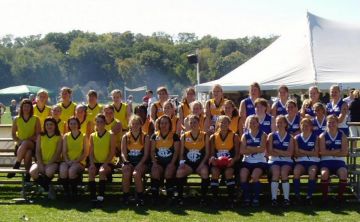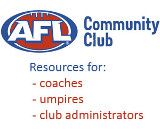A Decade in the Sun - Nationals Women's Division Turns 10
|
|
This weekend, over 170 women representing 16 clubs will take part in the 2015 USAFL National Championships in Austin.
They also represent numerous municipalities beyond those on their jumpers. They are from a diverse multitude of backgrounds, vocations, ethnicities, and creeds, but they are united by the love of Australian Rules football and the life changing benefits that it has yielded.
For the group taking part in Austin, however, they represent just how far the women’s game has come in the USA in just a decade.
The 2015 competition commemorates the ten year anniversary of the inaugural contesting of the women’s division. That first weekend in Milwaukee saw a total of 33 women on three teams – the Arizona Lady Hawks, Atlanta Lady Kookaburras, and an all-comers side known as the Florida Fusion – vie for the first ever USAFL women’s premiership.
While 2005 marked the first year of organized competition, it wasn’t the first participation by women at Nationals. Two years earlier, in Kansas City, the first women’s exhibition game was held. Other than the “wrap rule” which replaced tackling, the rules were largely the same. Another exhibition was held in Atlanta the following year, and numbers were growing, both at Nationals and around the country.
That winter, Minnesota native Kathryn Hogg was named to the USAFL board as its first women’s director. Hogg had helped to organize the first exhibition matches, as well as the first inter-club match in 2004 between Arizona and the Orange County Bombshells.
By the next year, it was clear that the ladies of American footy were ready for their turn in the sun, and one of Hogg’s primary goals upon being named to the board was a competition of their own.
“The first order of business was that I wanted a women’s division,” she said in an interview for the league’s Nationals promo video in 2005. “Let’s try to boost it to the next level and get an actual tournament going on. Fortunately the board gladly said, ‘yes, absolutely.’
“We decided to play 9-a-side just to help the game grow so that we can have more teams and more players, and have a competition.”
Led by Nikki-Nicole Peoples and Judith Stein, Atlanta defeated the Fusion 41-13 in the first Grand Final. The Lady Kookas would repeat in each of the next two seasons, building a successful program behind coach Wayne Kraska. By then, tackling was introduced, the field had grown to six teams, and the first USA Freedom national team was formed to do battle with Canada as a curtain raiser to the 49th Parallel Cup.
Atlanta’s run ended in 2008 when another Kookaburras side, this one from Calgary, won their first championship 27-22, in arguably the most exciting women’s final in history. The Milwaukee Bombers would deny Calgary a chance at a repeat in 2009.
By Louisville 2010, the teams were playing 12-a-side, and the Denver Lady Bulldogs, who were founded just three years earlier, took home their first title in a 19-18 thriller over a combined Calgary/Montreal entry. Little did anyone know – outside of Denver, perhaps – that a dynasty was in the making. Denver has won every women’s final since then, sweeping aside all twenty-one opponents in that time.
The first 8-team field debuted in 2013, with teams now being able to field 16 on the ground. Not only has this helped develop the game, but also aided in preparation for international competitions where the standard 18-v-18 is the norm.
Heading into last year’s nationals in Dublin, five women had the distinction of playing in every women’s tournament: Hogg, Stein, Christina Licata, Drea Casillas, and Amy Bishop. Stein and Licata retired at the end of the 2014 season to take up coaching roles with their club teams (Licata with New York, Stein with Baltimore/Washington), as well as for the USA Freedom national team development program. Both will be on their teams’ sidelines, continuing their streak.
Hogg was instrumental in the startup of the Minnesota Freeze in 2005, and has served as coach for both the men’s and women sides. She still remains involved with the team as player-coach, as well as the Freedom national team program. The woman who was there at the beginning of it all was selected for the Freedom team in the inaugural women’s division of the International Cup in Australia in 2011.
For Licata, who debuted beside Casillas for Arizona, the memories of 2005 are still quite vivid. Her role in women’s footy has grown with the program here in the States, but she is still very much in awe of the progress that has been made.
“It's surreal to think that 10 years have passed since the first official women's competition at Nationals,” she reminisced. “For Drea and I, Nationals 2005 was actually our first ever game - wrap tackle, 9 a side. We've seen many women cone and go over the ten years, but interest and passion for the game has continued to grow.”
“After plenty more 9 a side games throughout the years, fielding two women's divisions at Nationals this year is an incredible milestone to hit on the 10th anniversary. It is a testament to the dedication that so many of these footy players have to the sport.”
Casillas remembers her debut in Milwaukee as well, and her first encounter, on the field at least, with Hogg. “My first Nationals was my first game,” she said. “I remember going up against Kat (who we quickly learned went by Bitch Kat). There were several times that she and I went for the ball and I just got thrown out of the way. Towards the end of the game, I once again went for the ball and managed to get away with the ball. I think I got tackled by someone else because I was so shocked that I didn't get creamed by Bitch Kat.”
Both Casillas and Licata both moved to New York in 2008 for their careers, and shortly afterwards started up the New York Lady Magpies. They were Grand Finalists in 2011, and with Licata at the helm, enjoyed their best season this year, losing just one game. The ‘Pies have also gained a large following back in Australia through their relationship with the Collingwood Football Club.
Several years after getting thrown about by Hogg, Casillas succeeded her as women’s coordinator, overseeing the next generation of the program’s iteration. She also serves on the USAFL board as its secretary. For her, the enjoyment of footy isn’t just bared from the game itself, but from the women who are involved in the game.
“It really takes a certain type of personality to play this sport as a woman. Many of the women who play are so incredibly intelligent, self-sufficient and leaders in their respective fields. Playing over the last 10 years has allowed me to play against selfless athletes on the field and adventurous, generous and kind leaders off the field. I consider myself pretty fortunate to be a part of this group of trailblazers.”
Amy Bishop’s path to the USAFL was a little different. Despite growing up in Queensland, “I didn’t even know what it was until [husband] Matt took me on our first date in late 2000. We lived in Sydney early on in our relationship and I enjoyed having a kick of the footy with our mates at the Manly-Warringah Wolves.
“I got to experience women’s footy first-hand when the competition started up in Sydney… it was brutal. I had zero desire to actually play the game.”
That changed somewhat when Matt and Amy moved to Washington, DC in 2005, where Matt got involved with the Baltimore-Washington Eagles. She and one of the player’s wives, named Kylie, started coming to training with the Eagles. Kylie contacted Hogg about playing at Nationals that year.
“I was sh*t scared,” she admits. “The 2005 Nationals was the first time I’d ever worn cleats, a mouthguard or tried to tackle someone.”
“It was fun. I even kicked a goal in my first game. Since then I have played on numerous teams with well over 100 different women from across the USA and Canada. I tried hard, but never could quite get a full team while in DC.”
The Bishops moved to Sacramento in 2008, and through Hogg, met Helen Mondia Harvey, who Amy Bishop described as a “footy crazed Sheila.” Harvey was an original member of the Orange County Bombshells, and played for the Fusion that first weekend in Milwaukee.
“Helen, Matt and I caught up of brunch one Sunday and quickly decided that there needed to be footy team here in Sacramento, so the SAFC began in 2009,” explained Bishop. “It took a number of years however of us to be able to field a side and it wasn’t until the 2011 Nationals in Austin, Texas when the first Sacramento women’s team of around 17 players took to the field.”
Many clubs have used the co-ed, non-contact game of version of the game to bring in recruits. DC, Sacramento, Golden Gate, Denver, and Columbus are among the places where it has driven the growth on both the men’s and women’s sides. Metro competitions give players a chance to get game experience ahead of intersquad matches and Nationals.
“Looking back, I am extremely impressed with how women’s footy has developed and where it is today,” says Bishop. “Not only the growth of the sport on the field, but the level of skills and style of play has evolved. Women’s footy is no longer and awkward game of tag-soccer, but a skillful, exciting game that draws the crowds. It’s impressive how clubs like Minnesota and Denver are able to draw such consistent numbers and skillful players who fall in love with the game.”
The future of the women’s game, from an organization standpoint, is in the hands of the Women’s Association Board, led by Casillas. With the changing dynamics of the teams, they have to adapt. Putting together a fair yet competitive competition is among those challenges. In the past, it’s been difficult to seed full teams against combined sides. With five clubs bringing enough for full teams to accommodate 16-a-side play, that made it a little easier.
“In past years, teams were inconsistent as to bringing full squads,” said Casillas. “Last year was the first year that we saw teams starting to become more consistent in numbers. This year, we knew that at least five teams would have full squads who are pushing the 24 player roster limit. Minnesota being the largest team, will have a full squad and a partial team in division two.
“We also have many teams who are new and developing. All of these teams are promising with a mix of extremely talented veterans and new players showing great potential and enthusiasm. To address this, the Women's Association Board followed the recommendations from the Nationals Planning Committee to have two separate divisions to maintain the level of competitiveness and equally highlight the women's teams with full squads and also the partial teams.”
And so, Division 1 will feature five clubs: Denver, San Francisco, Minnesota, New York, and Sacramento. They’ll play a round robin, and the team with the best record will be declared the champion. Division 2 will have four teams, playing either 12- or 14-a-side, each of which combine players from at least two clubs together. This too will be a straight round robin. One team features the Boston Lady Demons combining with the Columbus Jillaroos, as well as players representing three new outposts in the women’s game: Chicago, Tulsa, and Houston.
Because the expanded format stretched the time, field, and umpiring resources available on the weekend to its limit, the decision was made by the women’s board to eliminate the Grand Final from this year’s competition. Thus, every result and every point is crucial, especially if the champion is decided by percentage.
“The end goal is to have all teams with full squads,” explained Casillas. “In the meantime, we want all games and divisions to be as competitive as possible. This year, will be no exception. Expect the teams to be very competitive in D1. Each team have grown in numbers, improved in experience and are excited to play a round robin. D2 will be equally competitive. Numbers were a definite consideration when combining the various teams. There were several other factors that were considered to ensure that the combinations maintained overall competitiveness, including player experience, coaching availability, etc.”
While this Nationals will be a statement of the present and future of the game, there will also be an homage to the past. A tent at the ground in Austin will feature pictures of clubs from over the years. The Freedom will also be selling shirts to help support the program.
After the completion of games on Saturday, a picture featuring all of the players and teams involved will be taken, similar to the one at the top of this story. Those smiling pioneers, drinking in their accomplishment of simply beginning the program on that chilly fall weekend in October, 2005, set about to create something massive. And they have.
Cristina Licata, who is in the ’05 portrait in a plain yellow jumper with her trademark bandana, it’s a brilliant point of pride. And she perhaps summed it up best.
“Women have pioneered new teams in new cities, taken leadership roles in those clubs, inspired passion for this sport from rookies and veterans alike, and all the while, have grown as a tight knit community both on and off the field.
“I couldn't be prouder of the women who are the forerunners of footy in the US, and the women who have taken a chance on us and this wonderful sport. It proves that women can and will continue to change the game.”
|
|
|






